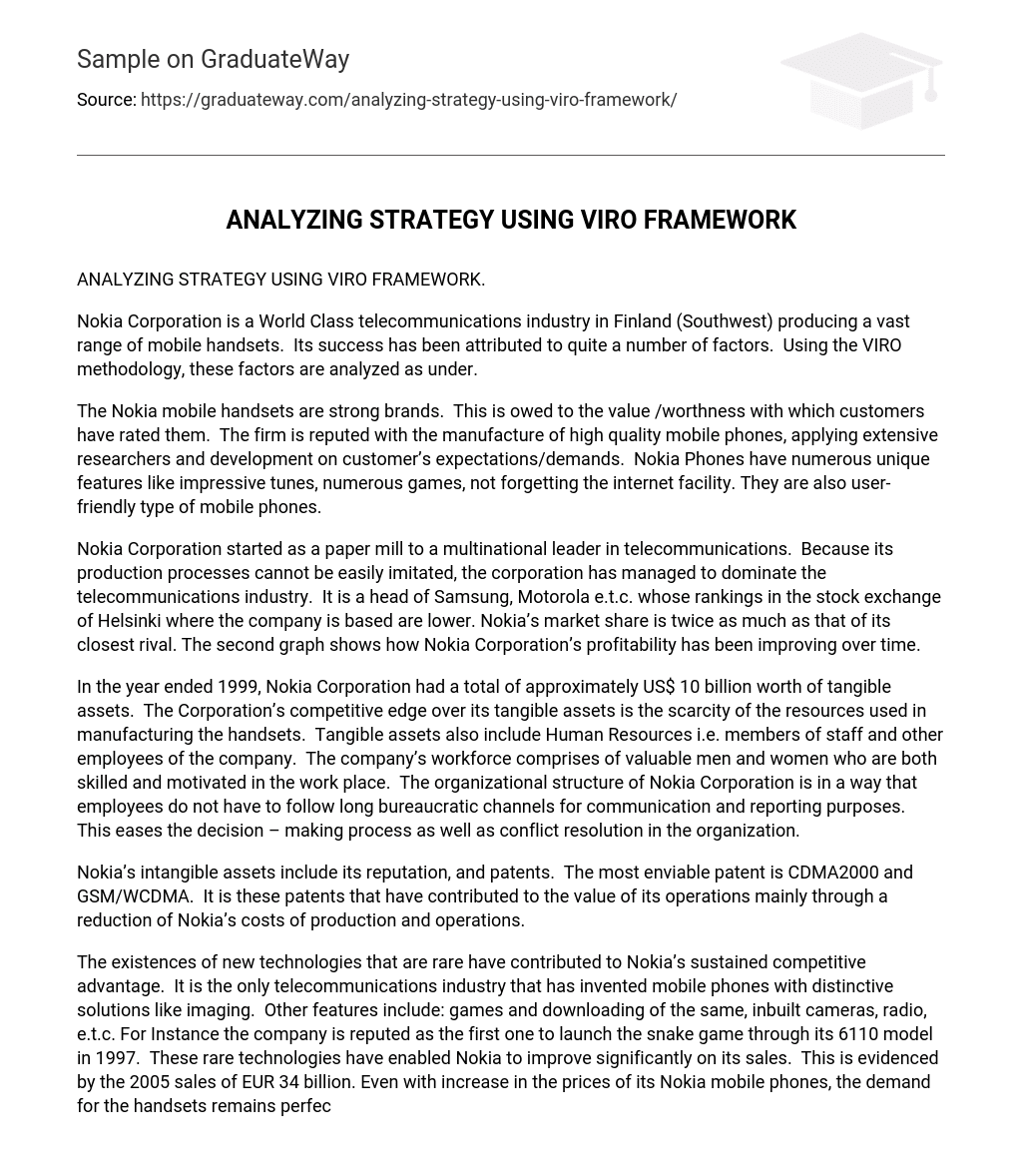ANALYZING STRATEGY USING VIRO FRAMEWORK.
Nokia Corporation is a World Class telecommunications industry in Finland (Southwest) producing a vast range of mobile handsets. Its success has been attributed to quite a number of factors. Using the VIRO methodology, these factors are analyzed as under.
The Nokia mobile handsets are strong brands. This is owed to the value /worthness with which customers have rated them. The firm is reputed with the manufacture of high quality mobile phones, applying extensive researchers and development on customer’s expectations/demands. Nokia Phones have numerous unique features like impressive tunes, numerous games, not forgetting the internet facility. They are also user-friendly type of mobile phones.
Nokia Corporation started as a paper mill to a multinational leader in telecommunications. Because its production processes cannot be easily imitated, the corporation has managed to dominate the telecommunications industry. It is a head of Samsung, Motorola e.t.c. whose rankings in the stock exchange of Helsinki where the company is based are lower. Nokia’s market share is twice as much as that of its closest rival. The second graph shows how Nokia Corporation’s profitability has been improving over time.
In the year ended 1999, Nokia Corporation had a total of approximately US$ 10 billion worth of tangible assets. The Corporation’s competitive edge over its tangible assets is the scarcity of the resources used in manufacturing the handsets. Tangible assets also include Human Resources i.e. members of staff and other employees of the company. The company’s workforce comprises of valuable men and women who are both skilled and motivated in the work place. The organizational structure of Nokia Corporation is in a way that employees do not have to follow long bureaucratic channels for communication and reporting purposes. This eases the decision – making process as well as conflict resolution in the organization.
Nokia’s intangible assets include its reputation, and patents. The most enviable patent is CDMA2000 and GSM/WCDMA. It is these patents that have contributed to the value of its operations mainly through a reduction of Nokia’s costs of production and operations.
The existences of new technologies that are rare have contributed to Nokia’s sustained competitive advantage. It is the only telecommunications industry that has invented mobile phones with distinctive solutions like imaging. Other features include: games and downloading of the same, inbuilt cameras, radio, e.t.c. For Instance the company is reputed as the first one to launch the snake game through its 6110 model in 1997. These rare technologies have enabled Nokia to improve significantly on its sales. This is evidenced by the 2005 sales of EUR 34 billion. Even with increase in the prices of its Nokia mobile phones, the demand for the handsets remains perfectly inelastic as shown in graph one.
On human resource management, the corporation recruits highly skilled manpower and retains them through motivation and training development. Using the VIRO tool of organization, such training & development has enabled their workers to effectively exploit Nokia’s resources since it acts like an incentive. Its management structure is not in a hierarchy form. This means that there exists a horizontal communication network. This has the effect of accelerating policy formulation and decision making processes.
Culturally, the employees of Nokia Corporation work towards accomplishing the objectives /goals of the firm. They have common beliefs and ways of doing things (Working). Because of this culture, the organization is able to resist such threats like labour turnover that can adversely affect the firm’s profitability since labour turnover is costly to any organization.
2002
2003
2004
2005
2006
YEAR
GRAPH ONE: Showing that demand for Nokia phones is perfectly inelastic.
The graph shows that even with the increase in the forces of Nokia brands mobile phones, the quantity demanded remains the same due to customer loyality and quality production.
P2
P1
P0
Q
P=Price
Q= Quantity demanded
Profit trend
REFERENCES
www.nokiausa.com
Collins, J. C. and J. I. Porras (1998). Built to last. London, Century Ltd.
Oakland, J. S. (2001). Total organizational excellence. Oxford,
Butterworth-Heinemann.
Europe.nokia.com
Powell, T. C. (1995). “TQM as competitive advantage. A review and
empirical study.” Strategic Management Journal 16: 15-37.





